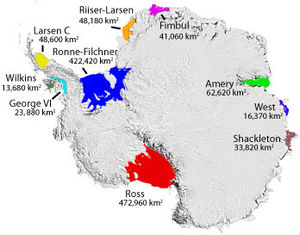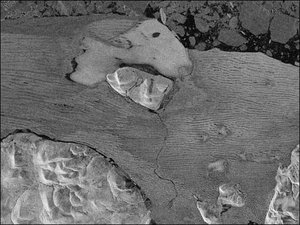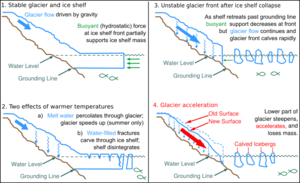Ice Shelf (About the EoE)

An ice shelf is a thick slab of naturally occurring ice, attached to a coastline and extending out over the ocean as a seaward extension of the grounded ice sheet. Ice shelves range in thickness from about 50 to 600 meters, and some shelves persist for thousands of years. The Antarctic Ice Shelves, fringing the continent of Antarctica, are the worlds largest collection of ice shelves; other prominent ice shelves occupy some of the fjords and bays along the Greenland and Ellesmere Island coasts. (An ice shelf occupying a fjord is sometimes called an ice tongue.)
At their seaward edge, ice shelves periodically calve icebergs, some the size of a small USA state or European country. Because they are exposed to both warming air above and warming ocean below, ice shelves and ice tongues respond more quickly than ice sheets or glaciers to rising temperatures.
Most of the world’s ice shelves hug the coast of Antarctica. Ten of Antarctica's 15 major ice shelf areas, appear in Figure 1. However, ice shelves can also form wherever ice flows from land into cold ocean waters, including some glaciers in the Northern Hemisphere. The northern coast of Canada's Ellesmere Island is home to several well-known ice shelves, among them the Markham and the Ward Hunt ice shelves.
Introduction
Ice shelves are typically formed from enormous ice sheets slowly oozing into the sea (Ice Shelf) through glaciers and ice streams. If the ocean is cold enough, that newly arrived ice doesn't melt right away. Instead it may float on the surface and grow larger as glacial ice behind it continues to flow into the sea. Along protected coastlines, the resulting ice shelves can survive for thousands of years, bolstered by the rock of peninsulas and islands. Ice shelves grow when they gain ice from land, and occasionally shrink when icebergs calve off their edges. This give and take helps them maintain a dynamic stability.
Ice shelves fall into three categories:

The Wilkins Ice Shelf is an example of a composite ice shelf comprised of both glacier-fed ice and fast ice thickened by snowfall. The others are glacier-fed, but ice formed from direct snowfall accumulation is a significant part of all permanent ice shelves.
Most ice shelves are fed by inland glaciers. Together, an ice shelf and the glaciers feeding it can form a stable system, with the forces of outflow and back pressure balanced. Warmer temperatures can destabilize this system by increasing glacier flow speed and by disintegrating the ice shelf. Without a shelf to slow its speed, the glacier accelerates. After the 2002 Larsen B Ice Shelf disintegration, nearby glaciers in the Antarctic Peninsula accelerated up to eight times their original velocity over the next 18 months. Similar losses of ice tongues in Greenland have caused speed-ups of two to three times the flow rate in merely one year.
While calving or disintegrating ice shelves do not raise ocean level, the resulting glacier acceleration does, and this poses a potential threat to coastal communities. More than 100 million people currently live within one meter of mean sea level. Greenland contains enough ice to raise sea level by seven meters, and Antarctica holds enough ice to raise sea level by 57 meters. While these ice sheets are unlikely to disappear anytime soon, even partial loss of the grounded ice could present a significant problem. In the coming decades of a climate warming era, ice shelves and ice tongues are likely to play a prominent role in changing the rate of ice flow off the major ice sheets.
Glacier-ice shelf interactions

Why are ice shelves important?
Because ice shelves already float in the ocean, they do not contribute directly to sea level rise when they break up. However, ice shelf collapse could contribute to sea level rise indirectly. Ice streams and glaciers constantly push on ice shelves, but the shelves eventually come up against coastal features such as islands and peninsulas, building pressure that slows their movement into the ocean. If an ice shelf collapses, the backpressure disappears. The glaciers that fed into the ice shelf speed up, flowing more quickly out to sea. Glaciers and ice sheets rest on land, so once they flow into the ocean, they contribute to sea level rise.
Research suggests that glaciers behind ice shelves may accelerate by as much as five times following a rapid ice shelf retreat[1].
What’s happening to Antarctic ice shelves?
In the last thirty years, scientists have observed a series of unusual ice shelf collapses on the Antarctic Peninsula. Although it is not unusual for ice shelves to calve large icebergs, that process normally takes months to years, as cracks slowly form in the ice. Following a calving, ice shelves generally recover over a period of decades.
In recent years, ice shelves on the Antarctic Peninsula and along the northern coast of Canada have experienced rapid disintegration. In March 2008, the Wilkins Ice Shelf in Antarctica retreated by nearly 1100 square kilometers (425 square miles). Later that summer, several ice shelves along Ellesmere Island in Northern Canada broke up in a matter of days.
In contrast, the collapses in previous years happened over a period of weeks, leaving a soup of chunky ice and small icebergs. The remaining ice shelves retreated by as much as 90 percent, and several have experienced repeated collapses.[2] [3]
What causes an ice shelf to collapse?
Scientists think that the recent ice shelf collapses in both the Arctic and Antarctica are related to climate change. Most of the rapidly retreating ice shelves in Antarctica are located on the Antarctic Peninsula. The Antarctic Peninsula juts north towards South America, into warmer waters. The peninsula has warmed 2.5 degrees Celsius (4.5 degrees Fahrenheit) since 1950, making it one of the fastest-warming places on Earth.
Scientists attributed rapid ice shelf collapse to warmer air and water temperatures, as well as increased melt on the ice shelf surface. Retreating sea ice may also play a role.
Warm air melts the ice shelf surface, forming ponds of meltwater. As the water trickles down through small cracks in the ice shelf, it deepens, erodes, and expands those cracks. In a separate process, warmer water melts the ice shelf from below, thinning it and making it more vulnerable to cracking. Scientists have observed both processes in all the ice shelves that have rapidly retreated in recent years.
However, warm temperatures alone do not fully explain rapid ice shelf collapse. Recent research suggests that waning sea ice surrounding the Antarctic Peninsula and the Arctic ice shelves in Canada might also have contributed to the recent collapses. Sea ice provides a layer of protection between an ice shelf and the surrounding ocean, muting the power of large waves and storms. As sea ice decreases, more waves buffet the ice shelves. The largest sea waves can buckle and bend an ice shelf, increasing instability and possibly contributing to a collapse.
Examples of Ice Shelves
Ice shelves are presently found in only three places: Antarctica, Greenland and Canada. Some notable examples of ice shelves are:
- Abbot Ice Shelf
- Ross Ice Shelf
- Wilkins Ice Shelf
See Also
References
Further Reading
- R.Greve and H.Blatter. (2009). Dynamics of Ice Sheets and Glaciers. Springer. ISBN 978-3-642-03414-5
- Martin O.Jeffries. Ice Island Calvings and Ice Shelf Changes, Milne Ice Shelf and Ayles Ice Shelf, Ellesmere Island, N.W.T.. Arctic 39 (1) (March 1986)
Citation
(2012). Ice Shelf. Retrieved from http://editors.eol.org/eoearth/wiki/Ice_Shelf_(About_the_EoE)- ↑ Antarctic Glaciers Accelerate in Wake of Ice Shelf Breakup, National Snow and Ice Data Center, 21 September 2004
- ↑ Wilkins Ice Shelf News and <a href="http://nsidc.org/news/press/larsen_B/index.html" rel="nofollow" title="http://nsidc.org/news/press/larsen_B/index.html">Larsen Ice Shelf Breakup Events</a> National Snow and Ice Data Center
- ↑ To learn more about the current state of ice shelves, see State of the Cryosphere: Ice Shelves.